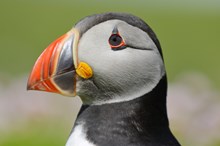01 April, 2019
Isle of May opens for the season with top 10 reasons to visit

This year’s chance to see thousands of spectacular seabirds, including the largest concentration of nesting puffins along the east coast, starts today with the public opening of the Isle of May’ reserve.
A record number of people visited the island in 2018 – over 13,500 visitors came ashore to the Scottish Natural Heritage (SNH) national nature reserve, making it the fourth consecutive year visitor numbers have grown.
But puffins are far from the only attraction. Isle of May reserve manager, David Steel, shares his top 10 reasons to visit this spectacular island.
- Enjoy a boat trip! The trip over to the May is rollicking good fun, led by knowledgeable guides, and will warm you up with a few bird sightings before you even reach the island.
- Experience the feeling of being inside a puffin snow globe. In spring, over 40,000 pairs of puffins return from the open sea where they have been since August. Birds bond for life and will use the same underground nest burrow, so watch out for adults ‘spring cleaning’ and pair bonding.
- Walk in the footsteps of the famous Robert Stevenson, the engineer who designed and built the impressive main lighthouse on the island in 1816. Climb to the highest point of the island to gain free entry to the lighthouse (weekends only) and enjoy the story of this magnificent building.
- Watch out for endearing eiders. Spring is the best time to see the largest nesting duck in the British Isles, with over 1,200 females nesting across the island. This loveable duck will sit tight on four to five eggs and will not move throughout her four-week incubation. Many will nest on the footpaths which criss-cross the island, so watch where you step!
- See the Isle of May in bloom. Following the long cold winter months, the island springs to life as the dormant season gives way to spring. Take in the display of the white sea campion which carpets the island, and the thrift (known as sea pink) which grows in the crevices of stone walls and the cracks of the rocks.
- Take in the sights, sounds and smells of the seabird city. Don’t miss the spectacle of thousands of cliff-nesting seabirds, including guillemots, razorbills, shags and kittiwakes on the high west cliffs of the island. Watch and listen to the buzz of activity and throng of birds as they return from the open sea, display with partners and squabble for nest sites.
- See seals hauled out on seaweed-covered rocks as they enjoy the spring warmth. The Isle of May is home to one of the largest grey seal colonies in the UK, with thousands giving birth in the autumn months. However, spring is also a good time to see the animals hauled out on the rocks.
- Enjoy the freedom of an island, breathing in the sea air and escaping the hustle and bustle of daily life. The island’s walks offer breath-taking views and if clear, there are views of the Forth Road Bridges out to the west, St. Abb’s Head to the south and the mighty Bell Rock lighthouse to the north.
- Experience the spiritual atmosphere of this special, historical place. Wander around the ruins of the medieval monastery. Learn about the significant role the island played in the history of early Christianity and about the hermits and monks who lived on the island from the 7th century.
- Learn more about the fascinating life of a modern-day Robinson Crusoe - meet the friendly SNH staff who will greet you on arrival to the island. The staff live and work on the island from March to November and deal with all aspects of island living from welcoming visitors to researching seabirds.
David adds, “This is an exciting time on the May. We’re all thrilled to be back, welcome the season’s first visitors, and see our first seabirds return, including the ever-popular puffins.
“There’s a whole variety of events coming up this season, including family fun days and a weekend celebrating the island’s seals. My advice to visitors of all ages is to book your place on a boat soon!”
To keep up-to-date on all the wildlife sightings, events and more on the Isle of May, follow the blog at https://isleofmaynnr.wordpress.com/ or the Facebook page at https://www.facebook.com/isleofmayNNR/
Background information
The May is open almost daily (weather dependent) from 1 April to 30 September with boats sailing from Anstruther harbour.
It’s free to visit the nature reserve, but you must take a boat trip to reach the island. Sailings are on the privately-run May Princess or Osprey of Anstruther from the Anstruther Harbour or through the Scottish Seabird Centre in North Berwick.
- Anstruther - for tickets and details, see isleofmayferry.com (May Princess) or www.isleofmayboattrips.co.uk (RIB Osprey).
- North Berwick - For tickets and details, book online on the Scottish Seabird Centre website at seabird.orgor call 01620 890 202.
Known locally as 'The May', this small island sits on the edge of the Firth of Forth. The island's importance for seabirds has drawn scientists to its shores for many years and the May is home to the oldest continuously running bird observatory in the UK. The May is also a regular haunt for grey seals, often seen lounging on the shoreline rocks. This island is a historical gem and has been a place of pilgrimage for centuries with an early island monastery. The May was also the site of Scotland's very first lighthouse, built in 1636, while the current, castle-like lighthouse was designed by the engineer Robert Stevenson.
ENDS
MEDIA QUERIES - for more information, contact snhmedia@nature.scot or 0131 316 2659.
Contact information
- Name
- NatureScot Media
- Telephone
- 0131 316 2655
- media@nature.scot
Notes to editors
Scottish Natural Heritage is the government's adviser on all aspects of nature and landscape across Scotland. Our role is to help everyone understand, value and enjoy Scotland's nature now and in the future. For more information, visit our website at www.nature.scot . SNH media is also on Twitter at http://twitter.com/nature_scot
The Isle of May is one of about 45 National Nature Reserves (NNR) in Scotland. NNRs are special places that look after some of the best of Scotland’s nature on behalf of everyone who lives or visits Scotland, and they provide unique opportunities to visit, enjoy and learn more about Scotland’s nature. For more information, see www.nnr-scotland.org.uk.
NatureScot is Scotland's nature agency. We work to enhance our natural environment in Scotland and inspire everyone to care more about it. Our priority is a nature-rich future for Scotland and an effective response to the climate emergency. For more information, visit our website at www.nature.scot or follow us on X at https://x.com/NatureScot
’S e NatureScot buidheann nàdair na h-Alba. Bidh sinn a’ neartachadh àrainneachd na h-Alba agus a’ brosnachadh dhaoine gu barrachd suim a chur ann an nàdar. Tha e mar phrìomhachas againn gum bi nàdar na h-Alba beairteach agus gun dèilig sinn gu h-èifeachdach le èiginn na gnàth-shìde. Tha an tuilleadh fiosrachaidh aig www.nature.scot no air X aig https://x.com/NatureScot




